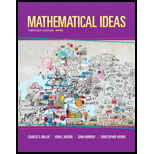
Mathematical Ideas (13th Edition) - Standalone book
13th Edition
ISBN: 9780321977076
Author: Charles D. Miller, Vern E. Heeren, John Hornsby, Christopher Heeren
Publisher: PEARSON
expand_more
expand_more
format_list_bulleted
Concept explainers
Textbook Question
Chapter 15.4, Problem 26E
The Jefferson and Adams methods are both subject to quota rule violations. But when violations do occur, one of these methods always apportions too many seats, and the other always apportions too few seats. Which is which?
Expert Solution & Answer
Want to see the full answer?
Check out a sample textbook solution
Students have asked these similar questions
voter who has a weight that is greater than or equal to the quota is called a dictator. In a weighted voting system, the dictator has all the power. A voter who is never a critical voter has no power and is referred to as a dummy. This term is not meant to be a comment on the voter's intellectual powers. It just indicates that the voter has no ability to influence an election.Identify any dictator and all dummies for the given weighted voting system. (Select all that apply.)
{19: 22, 6, 5, 3, 1}
Dictators:
the person with 22 votes
the person with 6 votes
the person with 5 votes
the person with 3 votes
the person with 1 votes
none of these
Dummies:
the person with 22 votes
the person with 6 votes
the person with 5 votes
the person with 3 votes
the person with 1 votes
none of these
Two states A and B have formed a 100- member commission to explore ways
in which they can work jointly to improve the business climate in their states. The
members will be apportioned to the commission according to the population of the two
states (using Hamilton's Method). After seeing the success of the commission, a third
state asks to join and appoint members to the commission. States A and B agree and will
allow state C to add as many members to the commission as they would deserve now
using the current standard divisor. The populations of the three states are given below.
Does this example illustrate the new states paradox? Explain.
State Population
A
2,000
B
7,770
C
600
A voter who has a weight that is greater than or equal to the quota is called a dictator. In a weighted voting system, the dictator has all the power. A voter who is never a critical voter has no power and is referred to as a dummy. This term is not meant to be a comment on the voter’s intellectual powers; it just indicates that the voter has no ability to influence an election.
a. dictators : v1,v2 ; dummies : v2,v3
b. dictator : v1; dummies : v2,v3,v4,v5
c. dictator : v1; dummy : v2
d. The system is not valid.
Chapter 15 Solutions
Mathematical Ideas (13th Edition) - Standalone book
Ch. 15.1 - Choosing a Poster Dog by the Plurality Method A...Ch. 15.1 - Choosing a Poster Dog by the Plurality Method A...Ch. 15.1 - Choosing a Poster Dog by Alternative Methods For...Ch. 15.1 - Choosing a Poster Dog by Alternative MethodsFor...Ch. 15.1 - Observing the Effect of the Number of Candidates...Ch. 15.1 - Observing the Effect of the Number of Candidates...Ch. 15.1 - Observing the Effect of the Number of Candidates...Ch. 15.1 - Observing the Effect of the Number of Candidates...Ch. 15.1 - Observing the Effect of the Number of Candidates...Ch. 15.1 - Observing the Effect of the Number of Candidates...
Ch. 15.1 - Applying Four Voting Methods to a Voter Profile...Ch. 15.1 - Applying Four Voting Methods to a Voter Profile...Ch. 15.1 - Applying Four Voting Methods to a Voter Profile...Ch. 15.1 - Applying Four Voting Methods to a Voter Profile...Ch. 15.1 - Applying Four Voting Methods to a Voter Profile...Ch. 15.1 - Applying Four Voting Methods to a Voter Profile...Ch. 15.1 - Applying Four Voting Methods to a Voter Profile...Ch. 15.1 - Applying Four Voting Methods to a Voter Profile...Ch. 15.1 - Holding a Runoff Election One common solution to...Ch. 15.1 - Prob. 20ECh. 15.1 - Prob. 21ECh. 15.1 - Prob. 22ECh. 15.1 - Prob. 23ECh. 15.1 - Prob. 24ECh. 15.1 - Prob. 25ECh. 15.1 - Prob. 26ECh. 15.1 - Prob. 27ECh. 15.1 - The Pairwise Comparison Method Each table...Ch. 15.1 - Prob. 29ECh. 15.1 - Prob. 30ECh. 15.1 - The Borda Method Each table represents a Borda...Ch. 15.1 - Prob. 32ECh. 15.1 - Prob. 33ECh. 15.1 - Prob. 34ECh. 15.1 - Prob. 35ECh. 15.1 - Prob. 36ECh. 15.1 - The Coombs Method The Coombs method of voting is a...Ch. 15.1 - Prob. 38ECh. 15.1 - Prob. 39ECh. 15.1 - Prob. 40ECh. 15.2 - Identifying Violations of the Majority Criterion...Ch. 15.2 - Identifying Violations of the Majority Criterion...Ch. 15.2 - Identifying Violations of the Majority...Ch. 15.2 - Identifying Violations of the Majority Criterion...Ch. 15.2 - Identifying Violations of the Condorcet...Ch. 15.2 - Identifying Violations of the Condorcet Criterion...Ch. 15.2 - Identifying Violations of the Condorcet Criterion...Ch. 15.2 - Identifying Violations of the Condorcet Criterion...Ch. 15.2 - Prob. 9ECh. 15.2 - Prob. 10ECh. 15.2 - Prob. 11ECh. 15.2 - Prob. 12ECh. 15.2 - Prob. 13ECh. 15.2 - Prob. 14ECh. 15.2 - Prob. 15ECh. 15.2 - Prob. 16ECh. 15.2 - Prob. 17ECh. 15.2 - Prob. 18ECh. 15.2 - Prob. 19ECh. 15.2 - Irrelevant Alternatives in a Hare Method Election...Ch. 15.2 - 21. Explain why a violation of the majority...Ch. 15.2 - Prob. 22ECh. 15.2 - Prob. 23ECh. 15.2 - Prob. 24ECh. 15.2 - Prob. 25ECh. 15.2 - Prob. 26ECh. 15.2 - Prob. 27ECh. 15.2 - Prob. 28ECh. 15.2 - Prob. 29ECh. 15.2 - Prob. 30ECh. 15.2 - Prob. 31ECh. 15.2 - Prob. 32ECh. 15.2 - Prob. 33ECh. 15.2 - Prob. 34ECh. 15.3 - Find each quantity (to the nearest whole number)...Ch. 15.3 - Find each quantity (to the nearest whole number)...Ch. 15.3 - Find each quantity (to the nearest whole number)...Ch. 15.3 - Find each quantity (to the nearest whole number)...Ch. 15.3 - Solve each problem.
5. New Trees for Wisconsin...Ch. 15.3 - Apportioning Computers to Schools Enrollments for...Ch. 15.3 - Assigning Faculty to Courses The English...Ch. 15.3 - 8. Apportioning Sailboats to Resorts The number of...Ch. 15.3 - Prob. 9ECh. 15.3 - 10. Show that the Webster method apportionment of...Ch. 15.3 - Prob. 11ECh. 15.3 - Prob. 12ECh. 15.3 - Prob. 13ECh. 15.3 - Prob. 14ECh. 15.3 - Prob. 15ECh. 15.3 - Find the Huntington-Hill cutoff point for rounding...Ch. 15.3 - Creating a Profile of School Bus Riders Create a...Ch. 15.3 - Prob. 18ECh. 15.3 - Prob. 19ECh. 15.3 - Prob. 20ECh. 15.3 - The standard quotas rounded up to the nearest...Ch. 15.3 - Prob. 22ECh. 15.3 - Prob. 23ECh. 15.3 - Prob. 24ECh. 15.4 - Quota Rule Violations with the Jefferson Method In...Ch. 15.4 - Quota Rule Violations with the Jefferson Method In...Ch. 15.4 - Quota Rule Violations with the Jefferson Method In...Ch. 15.4 - Quota Rule Violations with the Jefferson Method In...Ch. 15.4 - Alabama Paradox with the Hamilton Method In each...Ch. 15.4 - Alabama Paradox with the Hamilton Method In each...Ch. 15.4 - Alabama Paradox with the Hamilton Method In each...Ch. 15.4 - Alabama Paradox with the Hamilton Method In each...Ch. 15.4 - Population Paradox with the Hamilton Method In...Ch. 15.4 - Population Paradox with the Hamilton Method In...Ch. 15.4 - Population Paradox with the Hamilton Method In...Ch. 15.4 - Population Paradox with the Hamilton Method In...Ch. 15.4 - New States Paradox with the Hamilton Method In...Ch. 15.4 - New States Paradox with the Hamilton Method In...Ch. 15.4 - New States Paradox with the Hamilton Method In...Ch. 15.4 - New States Paradox with the Hamilton Method In...Ch. 15.4 - Violations of the Quota Rule? For each...Ch. 15.4 - Violations of the Quota Rule? For each...Ch. 15.4 - Violations of the Quota Rule? For each...Ch. 15.4 - Prob. 20ECh. 15.4 - Prob. 21ECh. 15.4 - Prob. 22ECh. 15.4 - Prob. 23ECh. 15.4 - Prob. 24ECh. 15.4 - Prob. 25ECh. 15.4 - 26. The Jefferson and Adams methods are both...Ch. 15 - How many different complete rankings are possible...Ch. 15 - Prob. 2TCh. 15 - Prob. 3TCh. 15 - Prob. 4TCh. 15 - Prob. 5TCh. 15 - Why is the irrelevant alternatives criterion an...Ch. 15 - Prob. 7TCh. 15 - Prob. 8TCh. 15 - Prob. 9TCh. 15 - Prob. 10TCh. 15 - Prob. 11TCh. 15 - Prob. 12TCh. 15 - Prob. 13TCh. 15 - Prob. 14TCh. 15 - Prob. 15TCh. 15 - Prob. 16TCh. 15 - Prob. 17TCh. 15 - Prob. 18TCh. 15 - Prob. 19TCh. 15 - Prob. 20TCh. 15 - Prob. 21TCh. 15 - Prob. 22TCh. 15 - Prob. 23TCh. 15 - Prob. 24TCh. 15 - Prob. 25TCh. 15 - One hundred seats are to be apportioned to 4...Ch. 15 - Prob. 27TCh. 15 - Prob. 28TCh. 15 - Prob. 29TCh. 15 - Explain the Alabama paradox.Ch. 15 - Prob. 31TCh. 15 - Prob. 32T
Knowledge Booster
Learn more about
Need a deep-dive on the concept behind this application? Look no further. Learn more about this topic, subject and related others by exploring similar questions and additional content below.Similar questions
- Jefferson's method, Webster's method, and Adams's method require using a _______ quota. arrow_forwardState A and state B are each candidates for an extra congressional representative. The relative unfairness of apportionment for state A is approximately 0.35, whereas for state B it is about 0.348. According to the apportionment principle, which of the two states should receive a new representative? Explain why. State A, because it has the larger relative unfairness. State A, because it has the smaller relative unfairness. State B, because it has the larger relative unfairness. State B, because it has the smaller relative unfairnessarrow_forwardProblem:Allocate 25 seats for five states whose populations are 12576, 13146, 14105, 13578, and 12986 respectively using The Adams Methodarrow_forward
- Problem:Allocate 25 seats for five states whose populations are 12576, 13146, 14105, 13578, and 12986 respectively using The Huntington-Hill Method PreviousNextarrow_forwardsuppose and electronics company has three divisions D digital C computers and B business products division D has 142 employees see has 84 and B has 27 assume that 12 member quality improvement counsel has membership on the council proportional to the number of employees in the three divisions a. apportion this council using Hamilton method b. now increase the councils size to 13 and then to 14 and apportion this council using Hamilton method. c. what is the first size above 12 when the Alabama paradox, occurs, and what division loses a seat when the size of the council increases.arrow_forwardA voter who has a weight that is greater than or equal to the quota is called a dictator. In a weighted voting system, the dictator has all the power. A voter who is never a critical voter has no power and is referred to as a dummy. This term is not meant to be a comment on the voter's intellectual powers. It just indicates that the voter has no ability to influence an election.Identify any dictator and all dummies for the given weighted voting system. {21: 14, 6, 5, 1} Dictators: the person with 14 votes the person with 6 votes the person with 5 votes the person with 1 vote none of these Dummies the person with 14 votes the person with 6 votes the person with 5 votes the person with 1 vote none of thesearrow_forward
arrow_back_ios
arrow_forward_ios
Recommended textbooks for you
 Discrete Mathematics and Its Applications ( 8th I...MathISBN:9781259676512Author:Kenneth H RosenPublisher:McGraw-Hill Education
Discrete Mathematics and Its Applications ( 8th I...MathISBN:9781259676512Author:Kenneth H RosenPublisher:McGraw-Hill Education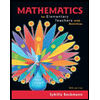 Mathematics for Elementary Teachers with Activiti...MathISBN:9780134392790Author:Beckmann, SybillaPublisher:PEARSON
Mathematics for Elementary Teachers with Activiti...MathISBN:9780134392790Author:Beckmann, SybillaPublisher:PEARSON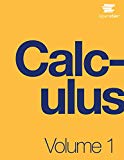
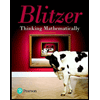 Thinking Mathematically (7th Edition)MathISBN:9780134683713Author:Robert F. BlitzerPublisher:PEARSON
Thinking Mathematically (7th Edition)MathISBN:9780134683713Author:Robert F. BlitzerPublisher:PEARSON Discrete Mathematics With ApplicationsMathISBN:9781337694193Author:EPP, Susanna S.Publisher:Cengage Learning,
Discrete Mathematics With ApplicationsMathISBN:9781337694193Author:EPP, Susanna S.Publisher:Cengage Learning,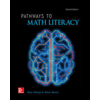 Pathways To Math Literacy (looseleaf)MathISBN:9781259985607Author:David Sobecki Professor, Brian A. MercerPublisher:McGraw-Hill Education
Pathways To Math Literacy (looseleaf)MathISBN:9781259985607Author:David Sobecki Professor, Brian A. MercerPublisher:McGraw-Hill Education

Discrete Mathematics and Its Applications ( 8th I...
Math
ISBN:9781259676512
Author:Kenneth H Rosen
Publisher:McGraw-Hill Education

Mathematics for Elementary Teachers with Activiti...
Math
ISBN:9780134392790
Author:Beckmann, Sybilla
Publisher:PEARSON


Thinking Mathematically (7th Edition)
Math
ISBN:9780134683713
Author:Robert F. Blitzer
Publisher:PEARSON

Discrete Mathematics With Applications
Math
ISBN:9781337694193
Author:EPP, Susanna S.
Publisher:Cengage Learning,

Pathways To Math Literacy (looseleaf)
Math
ISBN:9781259985607
Author:David Sobecki Professor, Brian A. Mercer
Publisher:McGraw-Hill Education
Propositional Logic, Propositional Variables & Compound Propositions; Author: Neso Academy;https://www.youtube.com/watch?v=Ib5njCwNMdk;License: Standard YouTube License, CC-BY
Propositional Logic - Discrete math; Author: Charles Edeki - Math Computer Science Programming;https://www.youtube.com/watch?v=rL_8y2v1Guw;License: Standard YouTube License, CC-BY
DM-12-Propositional Logic-Basics; Author: GATEBOOK VIDEO LECTURES;https://www.youtube.com/watch?v=pzUBrJLIESU;License: Standard Youtube License
Lecture 1 - Propositional Logic; Author: nptelhrd;https://www.youtube.com/watch?v=xlUFkMKSB3Y;License: Standard YouTube License, CC-BY
MFCS unit-1 || Part:1 || JNTU || Well formed formula || propositional calculus || truth tables; Author: Learn with Smily;https://www.youtube.com/watch?v=XV15Q4mCcHc;License: Standard YouTube License, CC-BY